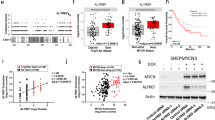Abstract
PML/RARα is the abnormal protein product of the Acute Promyelocytic Leukemia-specific 15;17 translocation. Both the PML and RARα components are required for the PML/RARα biological activities, namely its capacity to block differentiation and to increase survival of haematopoietic precursors. The physiological role of PML and its contribution to the function of the fusion protein are unknown. PML localizes to the cytoplasm and within specific nuclear bodies (NBs). In vitro, overexpression of PML correlates with suppression of cell transformation. The PML aminoterminal portion retained within the PML/RARα protein contains the RING finger, two newly defined cystein/histidine-rich motifs called B-boxes (B1 and B2) and a coiled-coil region. We report here that PML has a growth suppressive activity in all the cell lines tested, regardless of their transformed phenotype, and that the cellular basis for the PML growth suppression is induction of apoptotic cell death. Analysis of various nuclear and cytoplasmic PML isoforms showed that the PML growth suppressive activity correlates with its nuclear localization. Analysis of the localization and growth suppressive activity demonstrated that: (i) the Ring+B1-B2 and coiled-coil regions are both indispensable and sufficient to target PML to the NBs; (ii) individual deletions of the various PML domains have no effect on its growth suppressor activity; (iii) the Ring+B1-B2 region exerts a partial growth suppressor activity but its fusion with the coiled-coil region is sufficient to recapitulate the suppressive function of wild type PML. These results indicate that PML is involved in cell survival regulation and that the PML component of the fusion protein (Ring+B1-B2 and coiled-coil regions) retains intact biological activity, thereby suggesting that the effects of PML/RARα on survival derive from the activation of the incorporated PML sequence.
This is a preview of subscription content, access via your institution
Access options
Subscribe to this journal
Receive 50 print issues and online access
$259.00 per year
only $5.18 per issue
Buy this article
- Purchase on Springer Link
- Instant access to full article PDF
Prices may be subject to local taxes which are calculated during checkout
Similar content being viewed by others
Author information
Authors and Affiliations
Rights and permissions
About this article
Cite this article
Fagioli, M., Alcalay, M., Tomassoni, L. et al. Cooperation between the RING+B1-B2 and coiled-coil domains of PML is necessary for its effects on cell survival. Oncogene 16, 2905–2913 (1998). https://doi.org/10.1038/sj.onc.1201811
Received:
Revised:
Accepted:
Published:
Issue Date:
DOI: https://doi.org/10.1038/sj.onc.1201811
Keywords
This article is cited by
-
PML: Regulation and multifaceted function beyond tumor suppression
Cell & Bioscience (2018)
-
The function, regulation and therapeutic implications of the tumor suppressor protein, PML
Cell & Bioscience (2015)
-
PML-mediated signaling and its role in cancer stem cells
Oncogene (2014)
-
The Role of PML in the Nervous System
Molecular Neurobiology (2011)
-
Immunohistochemical expression of promyelocytic leukemia body in soft tissue sarcomas
Journal of Experimental & Clinical Cancer Research (2008)



